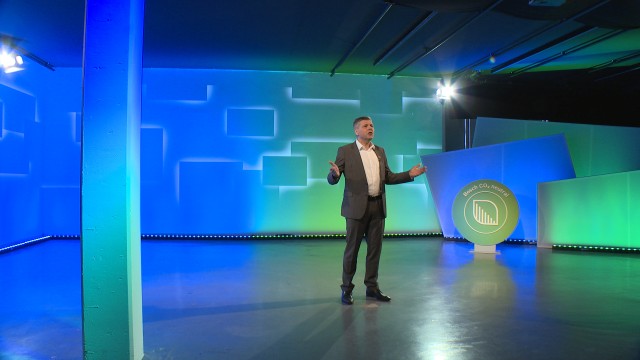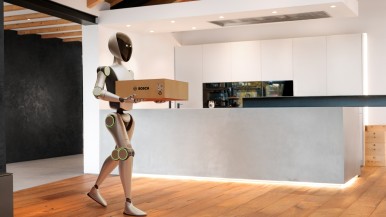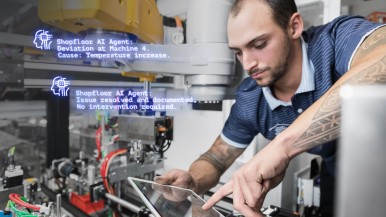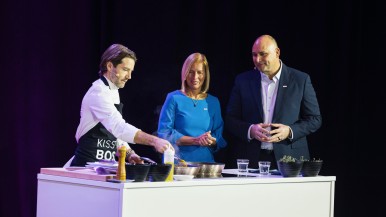Dr. Michael Bolle,
member of the board of management
of Robert Bosch GmbH,
and Mike Mansuetti,
president of Bosch in North America,
for broadcast at the Consumer Electronics Show
on January 11, 2021
Good morning – or depending on where you are – good afternoon or good evening, ladies and gentlemen.
Welcome to this world-first digital Bosch press conference at CES. Even though nothing can replace face-to-face interaction, and the excitement of seeing innovations first hand, we absolutely believe that everyone’s health and safety comes first. As such, we’re very pleased that the CTA was able to realize an alternative format for us all to come together virtually and share information about all the latest developments in the world of technology.
Every year, thousands of people come together at CES and discuss how technology can improve our lives. Over the past few months, however, we’ve had the truth of this demonstrated in unprecedented ways. A few decades ago, a pandemic such as the one we’re experiencing would have meant the total breakdown of our social and working lives. Today, we can at least talk and laugh with our loved ones via screens, even if we can’t see them in person. And thanks to the technology that makes remote working possible, hundreds of millions of people have seen little to no drop in their productivity.
From our perspective, this only confirms what we’ve known all along. At Bosch, using technology to improve people’s lives is at the core of our strategic imperative “Invented for life.” Today, we’d like to give you some examples of how we’re harnessing the power of cutting-edge technologies like AI and connectivity to help us overcome some of the biggest challenges of our time – in particular, those involving our own health and the health of our planet.
Climate change remains our biggest threat – and top priority
Living through a global health crisis this past year, we’ve had the chance to reflect on the broader meaning of “Invented for life.” If anything, focusing on the global existential threat from the pandemic has strengthened our resolve to play our part in tackling the even greater existential threat facing us all: climate change. In many ways, both challenges require colossal effort and collaboration to change the course. This is why we see it as particularly important that we continue to lead by example and push forward with our comprehensive sustainability efforts – even in the face of the current economic uncertainty. After all, while climate action costs money, doing nothing will cost even more.
Ladies and gentlemen, eighteen months ago, we announced our intention to make all Bosch locations carbon neutral by the end of 2020. We kept our promise and were the first global industrial enterprise to achieve this: according to internal calculations, we are now climate-neutral. This means that our 400 locations worldwide no longer leave a carbon footprint, and we expect to soon have confirmation in the form of an independent auditor’s report. As a validation of our achievement, we just received word that we’ve been included on the prestigious “A” list published by the Carbon Disclosure Project, a non-profit organization that ranks the environmental impact of companies and cities worldwide.
To make this success possible, we’ve applied four strategies: increasing energy efficiency, expanding the production of renewable energy, procuring more green electricity, and offsetting unavoidable CO₂ emissions. In fact, no other industrial company has made a voluntary commitment to carbon neutrality that can compare with ours in terms of scope and time frame. But we also didn’t conjure this commitment out of thin air. It’s a logical consequence of our long-term strategy at Bosch.
Now that we’ve met our carbon neutrality goal, we’re not slowing down. In fact, we’re shifting our focus to an even bigger challenge: the emissions of our entire value chain – from the goods we purchase to the disposal of the products we sell, across all of our business areas. The emissions from these upstream and downstream sources are 100 times greater than the emissions of our locations at the time we announced our carbon-neutrality target. By 2030, our goal is to reduce these emissions along our entire value chain by 15 percent. This is not a number we came up with on our own. We agreed to this goal with the Science-Based Targets initiative, an international partnership set up to facilitate swift climate action in the private sector. We are the first automotive supplier to join this effort with a defined target.
Think of it like a multiplier effect: the more people along our value chain we get on board, the more impact we can have.
If you were with us two years ago, you might remember that we launched our acclaimed “Like a Bosch” campaign right here at CES. Well, we’re doing it again! The newest installment in the series calls on everyone to “live sustainable like a Bosch” and join us in fighting climate change.
Sustainability anchored in product portfolio
As we show in the campaign, our products themselves are a major focus of our sustainability efforts. On the consumer side, they help people reduce their environmental footprint. Our state-of-the-art heating systems, for example, can help individual households save 2.5 tons of CO₂ annually in Germany alone. And, our dishwashers equipped with Zeolith technology offer an energy savings of up to 20 percent. Our washing machines help people to save water. Our durable power tools feature intelligent power management technology that increases their lifespans – and helps people reduce electronic waste.
And in our core mobility business, our wide variety of solutions and services help people reduce their carbon footprint. Here, we’re working toward a vision of mobility products that, when employed, can have no negative impact on the global climate and urban air quality. To pursue our vision, we’re developing a full range of powertrain solutions – from combustion engines to battery-electric powertrains to fuel cells, powering everything from e-bikes to trucks.
For more than ten years, our eBike Systems division has been setting new standards with high quality drive systems, consisting of drive units, batteries, and smart control panels for electric bicycles. The latest generation of our Nyon control panel, for example, offers on-board navigation, fitness tracking, digital locking, and topography-based range estimates – and is a CES 2021 Innovation Award honoree.
When it comes to vehicle-based e-mobility, we have a more broad-based portfolio than any other company. Early on, we started applying our knowledge – and a great deal of financial resources – to help
e-mobility achieve a breakthrough. Last year alone, Bosch invested more than 600 million dollars (500 million euros) in electromobility. Our electrical powertrain components are featured in more than 1.5 million vehicles around the world. From powertrains to steering systems to brakes, we have all the building blocks for electrification in our portfolio.
AIoT as complementary driver of strategy
Alongside climate action, another major pillar of our strategy at Bosch is driving forward advances in AIoT – where AI meets the internet of things. In fact, these two strategic paths are strongly intertwined, with AIoT and data often holding the technological key to enabling greater sustainability. This is the case, for example, with our cloud-based Energy Platform, which optimizes equipment and processes in manufacturing operations. It uses intelligent algorithms to help predict energy consumption, avoid peak loads, and correct deviations in typical patterns of consumption. This helps reduce CO₂ emissions in factories; for example, Bosch’s lead plant for Industry 4.0 in Homburg, Germany, cut its emissions by some 10 percent within two years. The solution is already in use at more than 100 Bosch locations worldwide, including for example in Charleston, South Carolina, and is also being marketed to other companies.
And we’re not the only ones to have uncovered the link between technology and sustainability. According to a recent study conducted in Germany, comprehensive digitalization in the mobility, manufacturing, and building technology segments could help the country get nearly halfway to the emissions targets it pledged as part of the Paris Agreement (source: Accenture). Another study identified digital solutions as indispensable enablers in meeting all 17 United Nations Sustainable Development Goals (source: Econsense). This comes as no surprise to us: we’re so convinced of the beneficial potential of AI and connectivity, we aim to be a leading AIoT company in every domain we operate.
In the case of AI in particular, we’re pursuing development along a path we call “industrial AI.” For many other tech companies, artificial intelligence is primarily about creating models of human behavior, focusing especially on purchasing preferences. Our approach, by contrast, focuses on the world of objects and their interaction with their environment. Whether in an automotive emergency braking assistant or when identifying faulty parts in production – in these cases, artificial intelligence is not telling machines what people are doing, but explaining the physical world to machines. In this way, we can enable intelligent behavior and optimize the way they work. We want to harness the potential of artificial intelligence to improve people’s lives. To help us stay true to this aim, we’ve created an AI code of ethics for our development and application of AI, especially in cases of doubt and dilemma. Ultimately, though, we will only be able to tap its full potential if we can convince people of the benefits of AI – and above all build trust in the technology.
AIoT for health and home applications
Nowhere are these benefits as obvious as in the domains of health and well-being. Here, the combined challenges of the pandemic and climate change have offered us another opportunity to demonstrate how literally we take our strategic imperative “Invented for life.” In recent months, that has meant a focus on developing and producing technological solutions for the fight against the virus.
The solution we’re most proud of in this regard is our rapid test for coronavirus. Using our mobile Vivalytic medical analysis device, we developed the PCR test in six short weeks and launched it in March of last year. Offering an initial time-to-result of two and half hours, we have since shaved this down to less than 30 minutes for positive samples. We also adapted the test cartridges to accommodate up to five samples simultaneously, thus boosting capacities considerably. The tests are currently in use in a variety of settings from nursing homes to doctors’ offices. We’re currently ramping up production with the aim of increasing our testing capacity to three million this year.
As for how it harnesses AIoT, this connected device gets software updates via our Vivasuite cloud platform – all it needs is an internet connection. That means when we reduce turnaround time for our Covid tests, devices deployed in the field are also automatically updated with the optimized procedure.
Our new open security camera solution from our Security and Safety Things startup addresses a very different kind of pandemic-related need. This camera ecosystem – which is another 2021 CES Innovation Award honoree – allows cameras of different manufacturers to be equipped with customized applications. Among these is an AI-based one which enables, for instance, customer numbers in retail spaces to be automatically detected and limited in accordance with local Covid regulations, or the presence of facial coverings to be verified.
For private households, we’ve developed a smart solution in the form of an innovative air-quality sensor. Along with conventional indicators including temperature, humidity, and air purity, this new sensor can also measure the amount of exhaled air and aerosols present in a room. Based on these readings, it can alert you when ventilation is needed, as both can be a risk factor in Covid transmission. This new sensor is being built into two of our existing smart-home products: our Twinguard intelligent smoke detector.
Although we’re currently devoting a lot of resources to Covid, it’s certainly not the only disease we’re using technology to fight. For instance, we’ve just developed a new mobile anemia screening solution, which is also a 2021 CES Innovation Award honoree. Our hemoglobin monitor is a compact, non-invasive, point-of-care solution powered with machine learning algorithms. Delivering results within 30 seconds, it offers a fast and reliable method of diagnosing and monitoring anemia, which is responsible for a million annual deaths worldwide.
Of course, health is about more than just treating and preventing disease. With this in mind, we’re premiering a new AI-enabled sensor for devices that many of us use to help keep ourselves in optimum form: wearable fitness trackers. Bosch Sensortec has developed a revolutionary self-learning motion sensor that adds artificial intelligence to portable devices. Among other things, it enables them to recognize and record any type of fitness activity that is based on repetitive, cyclical patterns. And thanks to the use of edge AI, where AI runs on the sensor itself, not only are latency and power consumption minimized, but user data remains fully private, since it doesn’t need a cloud connection or tethered smartphone to work.
Building expertise and exploring new horizons in AIoT
In our quest for AIoT leadership we’re not only focusing on technology, however, but also on people. Remember the AI training initiative at Bosch I announced last year? We’re now well on our way to training 20,000 of our associates in the principles of AI. And as a member of the CTA Apprenticeship Coalition, we recently launched an apprentice model focused on software engineering, or as we call it, our IoT apprenticeship, in the United States. The goals of this 12 month program are simple. First, we recruit talented non-engineers with transferable skills. Then, we train them in system architecture, design, and coding. And ultimately, we hope to employ these apprentices once their program is complete. Our IoT apprenticeship model is the manifestation of a “build” strategy for talent that helps us meet our software engineering needs in a very challenging recruiting environment.
Our first cohort of IoT apprentices includes a former chef, a shop technician, and a personal banking manager. It’s fascinating to hear what motivated them to make such a career change – some want to gain real-world technological experience. And some are looking for a chance to work on interesting projects. This team is engaged and ready to learn, and we are equally excited to see them embark on their IoT journey.
Speaking of updates, here’s one on our most far-out application of AI – quite literally! Last year I told you how NASA planned to install our SoundSee AI-based sensor system on the International Space Station, where it would perform deep audio analytics. I’m happy to say our system is indeed orbiting far above us. And, we’re collaborating with NASA on another AI-based application for space.
This time, our technology is going to the moon as part of NASA’s Tipping Point program. In partnership with Astrobotic, WiBotic, and the University of Washington, we’re going to be researching and developing technology for intelligent autonomous navigation and the wireless charging of small robots on the lunar surface. These shoebox-sized robots – called CubeRovers – will be equipped and trained to navigate the moon’s harsh, unpredictable conditions and get themselves to a docking station in an environment where GPS is not an option. Our researchers in Pittsburgh and Silicon Valley will be contributing their expertise in AI-driven intelligent data analytics and wireless connectivity solutions, with a goal of having the system demonstration-ready by mid-2023.
But back to Earth, and to the benefits AIoT technologies can deliver closer to home. In the mobility domain, they’re already demonstrating how they can help make getting from A to B more climate-friendly. Solutions for connected and automated driving can help eliminate gridlock and ensure smooth traffic flows in cities, which significantly reduces both consumption and emissions.
The same is true for parking, particularly in urban centers. Here, we’ve been continuing to refine our automated valet parking solution – and have now debuted this technology in the U.S. Last year, we teamed up with Ford and the real-estate developer Bedrock to demonstrate fully automated parking in Detroit. It was the first U.S. infrastructure-based solution for automated valet parking inside a parking garage. In Germany, Bosch is working with partners to provide the world’s first commercial automated valet parking service at an airport parking garage.
The AIoT is also enabling us to achieve sustainability gains via mobility-based services. Take electric-vehicle batteries, for example. To help maximize their lifespan and prevent premature aging, Bosch has developed a suite of “battery in the cloud” services that help to substantially improve batteries’ performance and extend their service life. Smart software functions in the cloud continually analyze the battery status and take appropriate action to prevent or slow down cell aging. This can reduce the wear and tear on the battery by as much as 20 percent which means replacement less often – and a better environmental profile.
The combination of electrified and automated driving – with personalized and connected services – is causing increasing demand for automotive software and electronics. Where a car included roughly 10 million lines of software code in 2010, the software of today’s non-automated vehicles already runs to 100 million lines of code. Tomorrow’s automated cars will require up to 500 million. At the same time, electronics engineering is becoming rapidly more complex, in line with more sophisticated vehicle functions.
In order for us to capitalize on our long-standing expertise in both of these domains, we are now pooling our software and automotive electronics expertise from the areas of driver assistance, automated driving, car multimedia, powertrain, and body electronics in a new division called Cross-Domain Computing Solutions, which started operation just ten days ago.
This division is home to 17,000 Bosch associates around the world, nearly half of whom are software engineers. In setting it up, we intend to master and reduce complexity in future vehicles through cross-domain software and electronics solutions. In particular, we’re focusing on powerful vehicle computers, which will take over from the multitude of individual control units used today. Our goal is to get new vehicle functions on the road significantly faster in the future, make cars more intelligent, and provide drivers with tangible benefits.
Sustainability and competitiveness are two sides of same coin
As all these examples show, Bosch is investing heavily – in promising technologies, in our workforce, and in our operations. We’re doing this to ensure our competitiveness in a world where climate change and a global pandemic are accelerating transformation and change. Our investments underscore the deep commitment we have to our role in creating a sustainable world for future generations, as well as our commitment to the future of our business. And in fact, we see no conflict between these: in our view, sustainability and profitability are two sides of the same coin.
First, pursuing sustainability is obliging us to pursue energy efficiency, which in turn is driving cost efficiency. Second, it’s enabling us to gain independence from rising energy prices. Third, it’s opening up new markets as we strive to satisfy growing demand for eco-friendly products. Fourth, it’s unlocking innovative potential as we are forced to think outside the box to develop climate-friendly solutions.
And last but not least, new business opportunities for us are emerging from these new green technologies and in the form of carbon-neutrality consulting and services. To this end, we’ve established our new Bosch Climate Solutions subsidiary, which provides an advisory service for other companies to help them become climate neutral. Our aim here is to pass on the knowledge and experience we’ve gained from achieving carbon neutrality and from projects we’ve successfully carried out worldwide.
Conclusion
Ladies and gentlemen, at Bosch we firmly believe that technological innovation, business success, and climate action are not mutually exclusive. But more than that, we believe that all three are interdependent: only companies that pursue sustainability today will be successful tomorrow, and only by harnessing the potential of technology will we succeed in combating climate change and challenges like Covid-19. This belief is the bedrock of our corporate strategy – and it’s the motivation behind our extensive portfolio of products, services, and business models that are true to our strategic imperative “Invented for life” in every possible sense of the term.
Thank you for joining us today. And please, stay safe and healthy.





